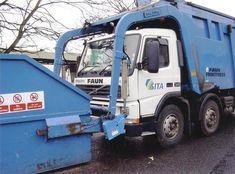
Gone are the days when companies could just dump all their waste into a skip and cart it off to landfill.
With the Waste Management Landfill Directive already forcing companies to re-think and re-budget for the way they dispose of waste, it is no surprise that health and safety also comes high on the agenda when the figures for accidents in the waste management industry are four times the national average, according to figures from the Health and Safety Executive.
So why are companies failing to implement adequate risk controls when it comes to manual handling, slips and trips and workplace transport?
Expense is often seen as a barrier when companies need to implement sufficient risk controls for their staff. But health and safety is a legal requirement and, if managed effectively, can actually save a business money in comparison to the cost of accidents and work place injury. There are also ways to improve your handling systems to decrease the level of waste produced and increase revenue too.
Some of the most common causes for accidents within waste management are:
• Lifting with too much force or awkward positioning and repetition of movement.
• Blocking walkways with unnecessary items.
• Creating an uneven terrain in and around work areas.
• Loading and unloading units using heavy equipment.
• Transferring materials/liquids from commercial vehicles.
Incidents are most commonly reported concerning employees who manually handle and sort waste but with some careful consideration and adequate training the risk of such accidents can be controlled.
A simple risk assessment will help to determine where your employees are at risk.
But what is a risk assessment? Quite simply, this is nothing more than a careful examination of what, in your workplace, could cause harm to people, so that you can weigh up whether you have taken enough precautions or should do more to prevent harm.
The aim is to make sure that no one gets hurt or becomes ill.
There are five steps to any risk assessment: firstly identify hazards, then decide who may be harmed and how, evaluate the risk and whether there are adequate precautions in place, record your findings (in writing if you have five or more employees) and regularly review your assessments.
What can I do to improve my waste working practices?
• Keep work areas, and access to them, clean, dry and free of debris to help minimise accidents.
• Install handrails or guardrails on elevated work platforms and train workers on fall hazards and use of ladders to help safeguard employees working at heights.
• Provide equipment in a convenient location.
• Implement regular vehicle inspections, maintenance and operating procedures.
• Action safe segregation of pedestrians and vehicles on site.
• Ensure equipment has the necessary rollover protection systems installed.
So how can you reduce waste disposal costs and improve safety for your employees?
Some waste management companies like Compact & Bale carry out vigorous waste and recycling reports for companies, free of charge.
“We work with companies throughout the UK in almost every sector of business and we find that the best way to help companies establish good waste management is to evaluate their working practices first,” says Steve Burnett, managing director of Compact & Bale.
Such a report will help companies to:
• Improve site safety.
• Free up valuable floor space.
• Reduce fire hazards.
• Reduce site traffic.
• Reduce waste disposal costs.
• Sell waste materials for profit.
• Reduce handling and labour.
• Implement a recycling policy.
“By decreasing the level of waste produced, companies can invest the money they would have spent on sending waste to landfill sites in some machinery and a good and safe waste management company to effectively recycle the waste they produce,’ says Burnett. “Good waste management can in fact save you money.”
An important factor is knowing where you stand with health and safety requirements. Meeting your responsibilities for health and safety can be challenging.
However, the consequences, both physical and financial, if you get it wrong, can be disastrous. Companies are legally required in the UK today to have in place a health and safety policy, undertake and document risk assessments, provide training to ensure safety on a wide variety of topics and devise and implement health and safety systems.
If you don’t have an in-house health and safety specialist there are many health and safety consultants who can guide your company on the right course of action to meet legislation and safeguard your employees.
Paula Seeman, from Ahead Start Consulting, says: “The law is absolute on this issue. An organisation must have access to designated, competent personnel to help them comply with the requirement specified within the Management of Health and Safety at Work Regulations 1999.
“You do not have to employ a health and safety officer full time on your staff to comply.
“Many companies large and small choose to outsource, opting to buy in expertise only when they need it rather then carry expensive overheads of a full time employee.”